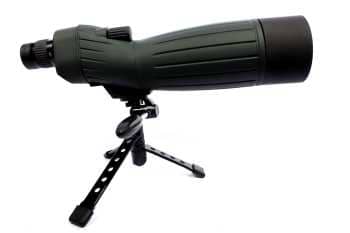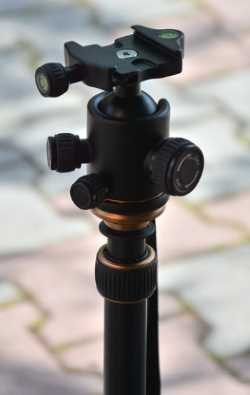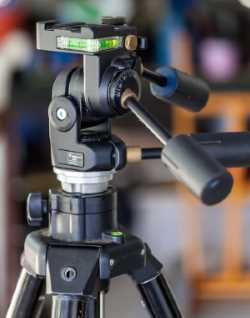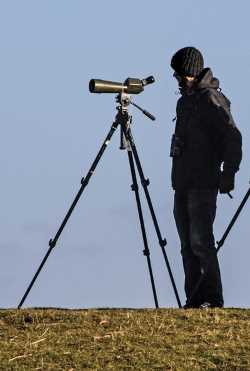Hold a spotting scope in your hands and try to use it at any decent zoom level and all you’ll see is a shaky image.
The shake comes from your hands, it’s perfectly natural, your hands are rarely absolutely still… just hold them up and look closely at them. They move ever so slightly to the beat of your heart if nothing else…. (at least mine do).
The further you zoom in with a handheld spotting scope the shakier the image gets as the more you magnify the image the more you magnify the shake!

You can rest your spotting scope on a pack, on the ground, or against a wall or on a tree, all these things will work to help eliminate the natural shake from your hands and make a handheld scope usable.
If you really want to keep your scope trained on a distant target, observe anything for any length of time, easily share the scope with others, digiscope (use a camera) or indeed use your spotting scope at its maximum magnification potential… you need a tripod.
Lots of spotting scopes come with entry level tripods, but the best accessories are never given away as freebies. With that in mind we’ve compiled this article to give you an insight into the features and facts about tripods.
What makes a good tripod and which one should you chose for your spotting scope?
Our Picks for the Best Spotting Scope Tripod
- Vortex Summit Carbon II – Best overall – Tough and steady but lightweight, this tripod will see you through any wilderness
- Vortex Optics High Country II – Designed with sturdiness, to protect your equipment. Includes a carry case
- Amazon Basics Pan/Tilt 60 – Great feature set for a great price – Best budget tripod
- Rangers 57in Ball Head – Versatile, transportable, great for outdoorsmen
- Vanguard VS-82 – Low center of gravity, small tripod great for heavy scopes
- UltraPod – A mini tripod you can attach at any height (with the right surroundings)
Full Size Tripods
Table Top / Mini Tripods
Note: Our individual reviews are below, but you can also click any of the links above to check current prices on Amazon and other retailers
You might also like:
If you haven’t already got a spotting scope, then take a look through our recommendations for the best spotting scope. For those of you tightening the purse strings you can also get a great budget spotting scope these days for really very little.
Maybe you’re a target shooter? Then your choice of scope will entirely depend on the distance you need to see. More distance = more money, we’ve covered many of these choices in these two articles, best spotting scopes for target shooting, and for archers scopes for upto 100 yards.
Table of Contents
Tripod Heads
Pan and tilt or ball? Which do you need?
Before we get into that, most importantly a good tripod head will specify the maximum weight requirements for the mounted device. If your spotting scope exceeds those weight limits then the head won’t hold your scope tightly, safely and it may well just flop. Make sure to check you aren’t using a spotting scope that’s too heavy for the tripod.
A ball head tripod will allow you to freely move the optic in all planes until you reach the desired orientation and then allow you to tighten and lock it into place using thumb screws or latches.

Ball heads are small, portable, and quick to operate and use but can be harder to fix precisely than a pan and tilt.
A pan and tilt heads come with either 1, 2 or 3 handles on the end of levers.
The handles normally twist to allow you to lock/unlock the orientation for that handle and either pan around left/right, tilt left/right or tilt on the forward/back axis.

Whilst a pan and tilt head allows you very precise control over the movement of your optic they are generally larger and more unwieldy.
Here’s a great video from a the school of photography explaining the differences between the types.
Quick Release Mounting Plates
Nearly all spotting scopes on the market today come pre-drilled with a ¼-20 (one quarter by twenty) thread hole. That’s an industry standard thread size found on scopes, cameras and binoculars and means that pretty much any tripod will work with any of the aforementioned devices.
At the head of the tripod you’ll either have a simple screw thread onto which you screw your spotting scope or, in the case of more useful models a quick release mounting plate.
Quick release plates can be easily and quickly detached from the tripod using a lever or clasp. The idea is that you mount the plate onto the scope and then just attach the scope quickly to the tripod (via the plate) every time. If you want to remove the scope, you leave the plate attached the use the quick release mechanism on the tripod.
These are great for applications where you want to switch between a spotting scope and tripod mounted binoculars quickly as you can get a quick release plate for both optics and leave them attached.
Types and Sizes of Tripod
If you’re seated at a shooting bench or some other type of table or maybe kneeling or lying prone and looking up a table-top or mini tripod will be your preference. These tripods are the smallest type and can add anywhere from 6” to 24” to the height of your scope..

If you need to use your spotting scope from a standing position, you’ll need to look for a full size tripod that can add anywhere from 24” up to 50”, 60” or 70” to the height of your scope.
It’s safe to say there are a host of tripods on the market with differing levels of extensibility and portability. The decision you need to make is what you want it for and how you will use it.
A full size tripod will be less portable than a table-top but generally more extensible and more planted and stable when being used from the ground.

Complete Tripods vs Legs and Heads
You can purchase tripod legs and heads separately and usually because there’s a standard fitting you can interchange them. Legs from one manufacturer should work with a head from another.
Buying this way means you’ll get exactly what you want, but you may pay more.
For relatively straightforward applications like spotting, a complete tripod will be the way to go.
Weight
Tripod legs are normally some form of aluminium tubing, but they can be made from lightweight materials like carbon fiber to keep weight down and still give a good strength to hold up the heaviest optics.
Generally the bigger the tripod the heavier it will be. A mini tripod will weigh less than a full size one. An aluminium tripod will weigh more than a carbon fiber one.
If want something that’s easily portable over long distances, weight and material composition will need to factor into your decision.
Carrying Case
If you’re going for a full size tripod, make sure to note what type of case is included (if any). A soft case is pretty standard, but not the ideal choice if you’re going to be stacking your kit into a truck for a long haul.
A hard case on the other hand will protect your gear from the knocks and bumps that come from any sort of regular travel and use, but isn’t going to be so compact.
Full Size Spotting Scope Tripod Reviews
Vanguard Alta
There’s not much the tripod doesn’t have. There are two purchasing options, and the largest has a maximum height of 70 inches, taller than most people. It has four collapsible leg sections, and when they’re all retracted, the tripod shrinks to a portable 25.4 inches.
The Vanguard Alta is what you need for that big hunting trip you’ve been planning. If you’re going out of state or even out of the country, it fits nicely in your luggage and doesn’t weigh you down. Despite the compact tripod design and light weight, it’s still a durable product that’ll survive whatever wilderness terrain you’re traveling to hunt thanks to 6X multilayering technology.
Speaking of wilderness terrain, the tripod is made to work effectively anywhere. Along with the collapsible legs that can all be extended to different lengths, three leg angles work to provide balance even on uneven ground. Plus, an anti-shock ring keeps your spotting scope stable.
You will have to go into a higher price range for this model, but for that you get a high-end product that’s user friendly. Setup is a breeze, and deployment in the field is even easier.
What we liked:
- 70 in collapses to 25.4 in
- Strong but lightweight 6X technology
- Three leg angles
- Anti-shock ring
- Easy setup
What we didn’t:
- Price range
- No carrying case
Vortex Summit Carbon II
If you ever worry about your scope or like to use an expensive camera with your scope tripod too, this model is about as secure as they get. The legs are anodized and sturdy, and rubber feet with 3 angle pivot locks give it a solid footing, even if you’re using it on wet or slippery surfaces.
Similarly, the 2-way pan/tilt head holds your scope at any angle, so you can get the best positioning with confidence. That way you can take advantage of the high-quality scope you paid for.
One of our favorite things is the detachable balance hook on the bottom. You can hang extra weight here to give you more stability, especially if the weather’s bad. The 4 section legs can be firmly secured into place with twist locks that are easy to use but do stay in place. The legs extend to a maximum height of 53.8 inches but collapse all the way down to 14″ inches.
What we liked:
- Rubber feet
- 2-way pan/tilt head
- Quick release plate
- Balance hook for extra weight
- Easy-to-use twist leg locks
- Carrying case
What we didn’t:
- Price range
Amazon Basics 60″
Honestly… Amazon are a behemoth and you can’t go far wrong with their basics range in any area. They’ve analyzed the competition using the incredible amount of data available to them, zoomed in on features and price point and produced some really good little pieces of kit.
Their Basics tripod comes in both 50”, 60” and mini format but we’re taking a look at the larger 60”variant.
Let’s start with the obvious, this tripod is affordable and it does most things you’d expect of a good tripod.
This is a pan and tilt design with a single handle and 2 axis of movement. The pan and tilt handle is not the quickest way of tracking something but is great for fine precision when you’ve located your target.
This tripod can hold a scope upto 3 kg in weight. That means it will work with pretty much any scope on the market. It has some features that most scope users will find unnecessary like a bubble level to indicate that the tripod base is level and another to tell you that the scope is level. It also allows mounting a camera in portrait mode, but again for scopes this won’t be any use.
There are however features that will work well for scope users like a quick release mounting plate and the ability to extend from 25” all the way up to 60”.
Adjustable rubber ends to the tripod feet mean you get grip on most surfaces and for windy conditions there’s also an accessory hook on the bottom of the center column of the tripod to allow you to hang an accessory bag or weight to help steady this against the wind.
- Affordable
- Light
- Soft Zipper Carry Bag
- Adjustable Feet
- Accessory Hook
- Features mainly designed for the camera user but works well for any application
Rangers 57″ Compact Ball Head
This is a versatile outdoorsmans tripod from Rangers with several features that hikers, and hunters will find to their liking.
You have a choice of how the legs are made with this model. Carbon fibre or aluminium alloy. The carbon is much more expensive than aluminium but does reduce the carry weight some. Those legs give this tripod extensibility from as low as 14” all the way up to 56”. The legs come in 4 sections and you adjust the aluminium legs using flip locks and the carbon using screw tighteners.
Flip locks are quicker to use than screw tighteners but sometimes don’t inspire confidence in the user that they’ll actually engage properly and hold the legs at any given length.
The head on this tripod is a ball, which is good for fast acquisition of targets as you get free movement in all 3 axis and a full 360° rotation before you’d need to use the large finger friendly locking knob to secure the scope in place.
There’s a quick release plate for mounting your scope which is great as you can easily get another and switch accessories without any hassle.
The way this is designed means that it folds down relatively small (14”) for transportation. Great if you’re going to hike or hunt.
- Good height range
- High 26kg load capability
- Accessory hook
- Transforms into a monopod / hiking stick
- Folds up small
- 6 year warranty
- Not the quickest of quick release mechanisms to use
Table Top / Mini Spotting Scope Tripod Reviews
Vanguard VS-82 Tabletop Tripod
A quality little 2 axis pan head table top tripod from Vanguard. This is only 9” high when folded up for transport and will extend to give you a maximum of 10.25” maximum height to your scope.
The construction is aluminium and there are rubber shoes on the legs to give you good grip on slippy surfaces like tabletops.
The legs on this tripod are angled to give it a good low center of gravity which means it’s ideal for handling things like heavy scopes. You can load upto 2.5 kg or 5.5 lbs onto this tripod without fear of it failing you.
That maximum weight limit is going to be sufficient for all but the largest of scopes. It’s also a feature you don’t find in many budget table top tripods.
What we liked:
- Great for heavy scopes
- 2 year warranty
- Compact when folded
- Rubber feet
What we didn’t:
- No quick release plate
- 2 way pan tilt only
UltraPod (Pedco)
Something a little bit different in design comes from Pedco. Their UltraPod tripod is designed to be very lightweight and strong.
This features a ball head that allows you to easily position a scope or camera at any angle and then tighten with the locking knob.
You can load upto 2.7 kg or 5.6 lbs onto that head, again great for larger scopes.
What’s cool about this design is that it’s incredibly light (only 4oz) and when the legs are folded together they compact up very very small (7”x2”x2”).
Because this is so small and takes up little space this is an ideal tripod for packing away inside your existing scope case or pack.
When folded up the legs on this tripod form a solid block and it comes supplied with a velcro cinch strap that you can use to attach that block to any nearby object such as a tree branch.
One thing this design doesn’t do however is extend. It’s a fixed height tripod, more of a stand really. But that velcro attachment means that with the right objects around you can turn this into a tripod of any height from tabletop to full size and higher.
A great versatile little tripod for the outdoorsman or hunter.
- Very light
- Compact
- Ball head
- Cinch strap for attaching to any object
- Fixed height
- No quick release plate